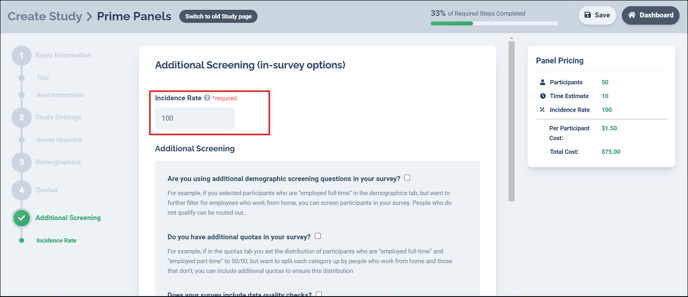Incidence rate refers to the percent of people sent to a study that will qualify. In other words, it is the percentage of people who pass within-survey screening question(s) and go on to take the study.
When running a Prime Panels study, you can screen participants within the survey for demographic characteristics that have not been previously profiled (i.e., for characteristics that are not available on the demographics options page). When screening participants within the survey, the percentage of people who are likely to pass your screening questions and continue to the survey--referred to as the incidence rate--becomes very important to both the cost and feasibility of your study.
Entering an Incidence Rate
When setting up a Prime Panels study you need to estimate the study's incidence rate. If you are not conducting any within survey screening, your incidence rate is 100%. If you are conducting within survey screening, you need to estimate the incidence rate based on what you know about the target population.

Guidelines for Estimating Incidence
Incidence rate is always based on participant targeting that happens within the survey. Therefore, any targeting that you configure at the platform level, will not alter your incidence rate.
The best way to estimate an incidence rate is often to use base rate statistics within the population or to conduct a small pilot study to examine the prevalence of a characteristic.
Determining Incidence Rate: An Example
Let’s say that your panel settings are configured to target men who make $100,000 or more per year. The incidence rate for your study would be 100% because the platform will target participants who meet this criteria.
However, let’s also say that you are actually interested in targeting men who earn over $100,000 per year AND who work from home. The panel probably does not have data on whether people work from home and because this is a characteristic that can change faster than a panel can update demographic information, screening within the survey is the most accurate way to identify participants who meet your criteria.
According to recent data, about 45% of Americans are working from home at least some of the time. Because working from home is more common among white-collar professionals, you can assume that a large percentage of men making over $100,000 also work from home. Therefore you might roughly estimate your incidence rate to be near 35 or 40%. Once you have an estimate for incidence rate, you can enter it into the incidence rate box.
![PP Knowledge Base_incidence rate [set to 45]_12.15.2021](https://go.cloudresearch.com/hs-fs/hubfs/PP%20Knowledge%20Base_incidence%20rate%20%5Bset%20to%2045%5D_12.15.2021.png?width=688&name=PP%20Knowledge%20Base_incidence%20rate%20%5Bset%20to%2045%5D_12.15.2021.png)
The incidence rate you estimate doesn't have to be perfect, but it does need to be close. Our system uses the incidence rate estimate to determine how many participants will need to be sent to your survey for you to reach your desired sample size. If the incidence rate estimate is off by a large margin, both the speed and cost of your study may be affected.
NOTE: Studies with low incidence rates (~25% or less) may not be feasible through our self-service system, but often can be run using our managed research service.